Category: Spirit
Sunday, Apr 1, 2018 | Art, Big Thoughts, Cartoons, Fire, Meditation, Peace, Spirit, Writing |
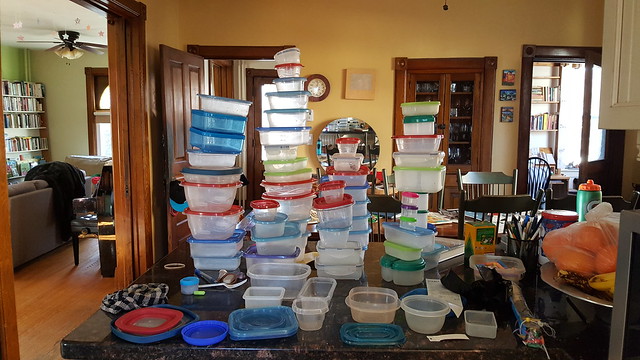
Every day I sit and draw, often for as long as an hour. I listen to music and pencil in lines on paper that recreate small scenes from my day. When I’ve pencilled in the lines to some satisfaction, I take my pen and ink in the drawings. If I had even more time, I would add watercolours. (I’m not ruling this out at some point in the future.) I’ve now drawn 92 daily cartoons and I’m aiming for 365. It’s often what I’m doing in the evening, instead of doing something else, but my evenings were never much use to me for writing anyway, as my brain seems to fog up. Drawing calls on something different than writing. Lines are different from words. Lines slow time. They’re meditative. My whole being follows the line. I can’t describe how content I feel while drawing. Why? Because I expect nothing. Because the discovery is always surprising. Because it occupies all the parts of me that would ordinarily be running madly off in all directions, it pulls them into cohesive effort. Because it stills my thoughts. It takes all of my focus even while making focus feel effortless.
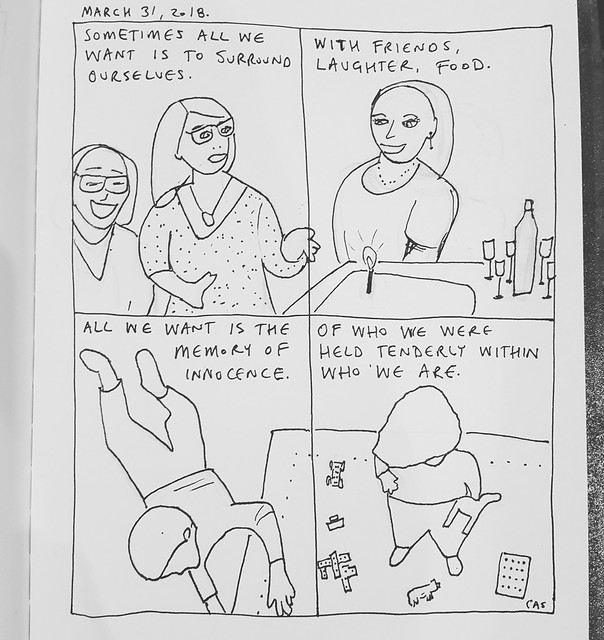
If I hadn’t gone to Lynda Barry’s workshop two summers ago, I would never have known this was possible — drawing. I never would have known, because I would have assumed, as I’d assumed since grade two, that I essentially stunk at art. I haven’t taken an art class since grade seven. Sometimes I wonder whether the concussions changed my brain in some subtle way that has allowed me to focus differently. I remember art class in grade seven — I dreaded it, in the same way that I dreaded sewing in family studies. I had no patience, none, for the projects we were assigned. I knew before I made something that it would be subpar, clunky, painfully literal, the colours weird and blobby, the angles wonky, a minor disaster in the form of clay or pastels or terry-cloth. And it always was.
The things we’re good at are almost inevitably the things for which we have terrific patience. I can polish a story for hours, for example, but I can’t even finish reading an article in the business section; it’s all in the attention, or the ability to pay attention.
I have no idea why I’m making these cartoons. But, you know, I have no idea why I write stories about made-up people. It’s all a bit absurd and indefensible. And it’s also awesome and wonderful, and I’m so damn lucky to have the time, freedom, tools, and privilege to unpack my deepest, most mysterious emotions in these ways. I would call it almost essential. Without art, without these creative forms of expression, I would be helpless beneath the weight of untranslated experience.
Sometimes it feels like I’m bursting to connect what’s inside me with everything that’s outside of me. At least to try. I think maybe all human beings have this need. We need to know our stories. We need release from our stories, too, or to integrate them into our selves, the way a tapestry may be woven from threads of many colour and textures. I sense in art the power to heal (which is different from the power to resolve or simplify or even to comfort). It’s the power of purpose. Art is action, at its core. At its core, it is connection.
xo, Carrie
Sunday, Mar 18, 2018 | Big Thoughts, Dream, Organizing, Party, Sleep, Spirit |

Last night I dreamed I was being chased by a man with a gun. I ran and hid while he hunted me down.
I woke and all the hairs on my arms were standing on end. My mind was racing. I lay there in the dark, looking at the ceiling, trying to get the picture out of my mind—of a man with a gun, pointed at me. What I thought about, too, as I lay there, too awake and disturbed to sleep, was what it would be like to have experienced a situation like that for real, like the kids of Parkland. What a name. Parkland. Sounds like the name you’d give to a wholesome suburban community, though possibly a satirically wholesome suburban community. I thought about waking in the night to stare at the dark, mind racing, after being in lockdown in your classroom, after hearing gunshots in your school’s halls, after seeing someone shot and killed, after hiding, terrified, thinking you will die. And I thought, the March for Our Lives is not hyperbole for these kids. I thought, if someone with a gun has come into your school, you understand, in a way that others may not, how dire the situation is, how far gone, and you’d do anything, now, to prevent this happening to another kid, in another school.
I thought, this won’t end until enough people refuse to accept it as their reality.
I’m so glad I don’t live in the United States. It breaks my heart to say so, because I am a dual citizen, and because dear friends and family live in the States and love their country, and because there are so many good and wonderful things in the US. I grew up in the States. It was once my home. I remember when Canada seemed terribly foreign, even though my dad’s family had Canadian roots. Canada was cold and unknown, and I didn’t want to move here. I was ten. I’ve never moved back to the States. I’m almost wholly Canadian now. We have our own problems and even our own gun problem; but it doesn’t compare, nothing compares to the madness of the gun—the worship of the gun—in the United States of America. It’s almost as if guns are more sacred than life itself, in the USA. Certainly, the right to own and carry a gun is more protected than the right to be protected from gun violence. If the best answer politicians can come up with is more guns, arm the teachers, “harden” the schools into what amount to prisons—that’s not protection for the kids, that’s protection for the guns, again. Sell more guns.
I want to march. I want to go to Washington and march against the almighty gun.
The kids who are marching, the kids who’ve organized this, the brave outspoken truth-telling kids of Parkland feel like they’re living in a war zone. They’re living in a developed nation, a nation of enormous prosperity and wealth, yet they are not safe—they know they are not safe. They know this will happen again, and again, and again, in churches, in schools, in homes,on streets, and so they march. I hope they never give up hope. I hope they march and march and march for their lives until they change the course of history. I’d believed for so long that there was no changing this story—that mass shooting would follow mass shooting would follow mass shooting, with nothing but thoughts and prayers to comfort the survivors. But these Parkland kids, they give me hope. They’re changing the narrative. They’re digging in their heels.
I always thought the gun would win, because don’t people with guns always win?
But, no, they don’t. They don’t. Violence doesn’t always win. Power and bullying doesn’t always win. Money doesn’t always win. Oh, how I want to believe this.
Oh, how I love the kids from Parkland.
xo, Carrie
Thursday, Feb 22, 2018 | Big Thoughts, Fire, Spirit, Stand, Work, Writing |
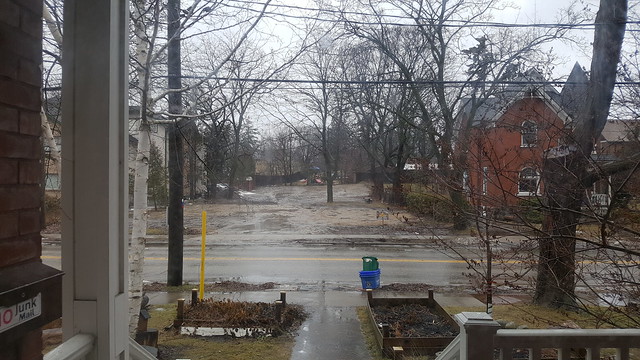
Earlier today I was writing, but then I had to stop writing because it was time to make a salad dressing, eat supper with my family, and clean up after supper. I was in a difficult part of the book, really struggling with it, and now I’m sitting down hours later, wondering how to find my way back in to that difficult spot? I feel a dull anger, but I don’t think it’s really to do with the interruption of thought, I suspect it’s a deeper frustration with my own inabilities to solve the problems in this book, which I fear I may not be clever enough or determined enough to do. The problem is that there is no big aha moment at the end of the book. There is no big reveal. No twist. The evil character remains evil. That’s another problem. The evil character is not an appealing and charismatic anti-hero who was once good and has fallen out of goodness, nor is he a polarizing or morally dubious character; no. All of his instincts and actions are reprehensible. Perhaps this points to a flaw in my imagination. I just can’t find his goodness, except possibly when he was a child. At the end of the book, has he changed? What’s revealed about him, ultimately?
So I sit here looking at the final page of this book, literally the final page, wondering where the redemption lies. Wondering whether this is a book about forgiveness or about revenge, or maybe it’s a book about being unable to forgive — and what happens then?
And then a few hours go by, and I’ve written a new ending that feels right, somehow, and the candle on my desk hasn’t burned out once this whole time. And now it’s bedtime. It’s getting late. I have a cartoon to finish and exercise early in the morning. It’s funny, and also comforting, to read what I wrote earlier in the evening. What I’ll probably remember about today is not the irritation or the frustration, which turned out to be momentary, fleeting, but the feeling of wholeness that arrived at the end of it all.
You have to withstand discomfort to make anything.
xo, Carrie
Friday, Jan 12, 2018 | Art, Feminism, Fire, Politics, Spirit, Stand |
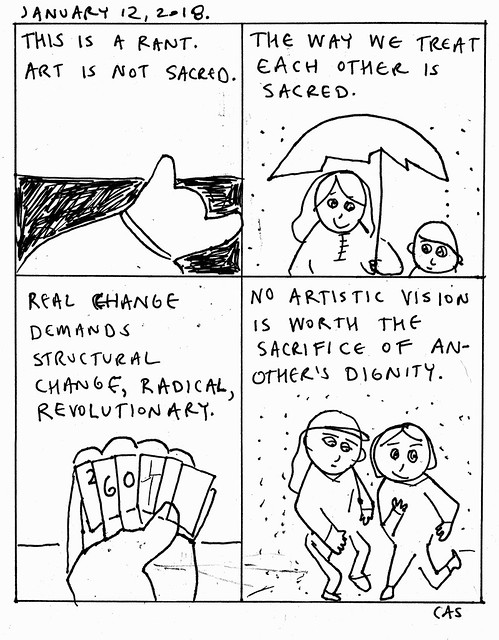
This is a rant. Art is not sacred. The way we treat each other is sacred. Real change demands structural change, radical, revolutionary. No artistic vision is worth the sacrifice of another’s dignity.
Today on our early morning run, Heather and I talked about structure. How humans hew to structure, even if it’s not serving us well, because that is our nature. Real change demands structural change; true on scales both macro and micro, societal and individual. I wish I had the tools and knowledge and education to do something that would support wide and deep systemic change. Or maybe that’s not how systemic change occurs. Maybe it’s more radical and revolutionary. I believe in policy, and the power of policy to affect change, but unless it’s applied, policy is worthless and sometimes worse than worthless — because it provides a mask to corruption while pretending to hold the system to account. Why didn’t they report earlier? Why are they coming out now? They should have gone to police. This is a case for the courts, not the court of public opinion. It’s nothing but unsubstantiated gossip. Fill out the paperwork, go through the proper channels, and we’ll get back to you.
Yeah, this is a rant.
This morning, I heard a snippet from a radio interview: a woman arguing that the penalties against the former director of Soulpepper theatre in Toronto were too harsh — He built the company! His artistic genius! (Full disclosure, one of the complainants in the civil case against him was a high school friend, though we haven’t been in touch for many years.) To the woman on the radio, I raged: You’re arguing that artistic vision is worth the sacrifice of people’s safety. You would protect a man whose behaviour at work harmed people — because he was a good fundraiser??? Because the art was good??? This is skewed morality.
Art is not sacred. The arts are not sacred.
The way that we treat each other as human beings is sacred, or should be.

For the second day in a row my old friend Kristin is on the front page of Canadian newspapers, one of four women accusing a director of sexual abuse. In our high school production of Anne of Green Gables, she played Diana to my Anne. We had so much fun. Kristin absolutely sparkled with wit and comedic talent. I am so proud of her bravery now.
I have a theory. Power may indeed corrupt and absolute power may indeed corrupt absolutely, but many who seek power are already corrupt, particularly in systems in which corruption, in its many forms, is rewarded: think manipulation, harassment, bullying, and other norm-flaunting, disrespectful, selfish and narcissistic behaviour. Those more inclined toward self-reflection, those who don’t want to harm others for their own profit (or be harmed), who don’t want to lie and self-inflate and backstab and cheat to “play the game” are weeded out of the system, deemed weak, losers, failures. The powerful believe their behaviour is normal.
Maybe we all do — until we don’t.
Let’s say that time is now. Let’s find ways to circumvent the system until the system changes.
I repeat: Art is not sacred. Neither are artists. The artistic process has never needed to be destructive, harmful, cruel, violent, vindictive, ugly, competitive, or vicious in order for good art to exist. Don’t be fooled by the propaganda.
Bottom line: If you’re hurting people in the process of making your art, you’re doing it wrong. You never earn the right to be an asshole. (Also, side note: nobody needs to see your penis.)
xo, Carrie
Monday, Jan 8, 2018 | Art, Big Thoughts, Fire, Meditation, Peace, Spirit, Word of the Year |

New ritual: I begin my desk-time by lighting a candle. The expectant flare of the match and comforting flickering flame marks a small opening moment to help me begin. The candle, which I almost felt ashamed of purchasing (impulse buy; no reason why; it was on sale), is suddenly useful, a tiny reminder of the word I’ve chosen to meditate on for this year: perhaps as a guide, perhaps as warning. Even the tiny flame of a single candle is mesmerizing, its movements mysterious, its light enticing.
FIRE.
The word fire initially drew my attention because I was thinking of creative fire, of passion, of burning brightly in pursuit of art. Which sounds howlingly pretentious, I realize. But I felt comforted by the image that accompanied the word: of a furnace, deep inside, glowing with steady bright heat.
Fire is dangerous, as elements are. I pictured, too, a fire that burns across a prairie, leaving behind blackened space, but also a place for new growth in fertile soil — not a wasteland, after all.
Fire is sacred, precious, life and death. Without it, we would be hungry and cold in the dark.
A fire either is, or is not. When I blow out this candle, its flame vanishes. What keeps a fire alive? It needs oxygen to burn, and energy. It devours fuel. Some fuel burns bright and quick, while other fuel burns slow and steady. But in time, all fuel will run out and must be replenished.
You can’t leave a fire untended. It will burn out, or burn out of control. Either way, it needs attention.
What fires am I tending now? What feeds my fire?
I think of the story of the Little Match Girl, which I adored as a child of melodramatic bent. How the brief flame of each lit match gave the girl temporary comfort and relief — and visions of warmth and plenty — even while she froze to death, shoeless, in the street. Fire as illusion of heat.
Fire as passion, fire as creative, fire as necessary; fire as destructive, fire as hungry, fire as all-consuming, insatiable.
I fear this word and yet it draws me. What would happen if I let my fire burn? What does that even mean? Do I know?
One last image that keeps coming around: Edna St. Vincent Millay’s poem “First Fig.”
My candle burns at both ends;
It will not last the night.
But ah, my foes, and oh, my friends —
It gives a lovely light!
xo, Carrie
PS The cartooning project continues, day by day. I’m posting a daily cartoon on Twitter and Facebook, and plan to use some here too, in future posts.
Friday, Jan 5, 2018 | Friends, Meditation, Spirit, Stand, Word of the Year, Work, Writing |

My word of the year for 2017 was STAND. As an exercise, partway through the year, I looked up all the meanings and synonyms for the word, and wrote them onto an index card that I carried around in my purse until at some point it turned into this stained and crumpled piece of paper you see above. The definition filled the entire card, in tiny letters, both sides.
1. v. To be upright, to be on one’s feet, to rise to one’s feet
2. v. Put, place, set
3. v. Take a position
4. v. Support, uphold, argue, champion, defend
5. v. Be present, remain, stay, exist, persist, continue, prevail, hold
6. v. Endure, abide, sustain, remain, last, bear up, carry on, withstand, suffer, submit to, face, weather, stomach, persevere
7. v. Be
There’s more, too. Of course STAND is also a noun with several meanings, including: position; kiosk; and a group of trees.
It was my original intention to explore meanings #3 and #4, above. I was going to take a stand and protest and speak out. But instead my year leaned heavily on #5 and especially #6. The many meanings of STAND expanded. The word took the shape of a tree in my mind, rooted with a strong spine, a good word and a good image for a year that rippled and buckled with unexpected heartache and news difficult to digest (most of which I’ve chosen not to write about on this blog, because it is either too personal or not directly my own story to tell).
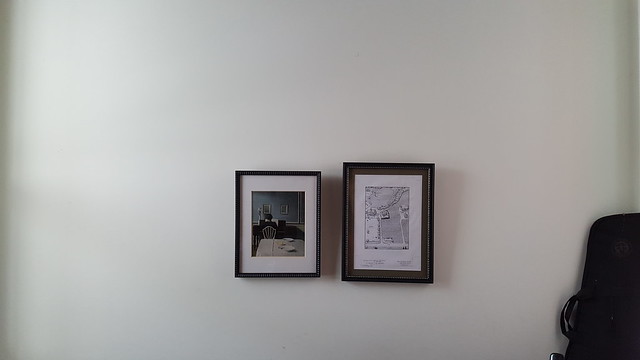
STAND came to feel like a necessary, useful word, easy to incorporate into my thinking. I finished the year with greater confidence and inner quiet, at least about my writing. The word, and especially the image of a tree, seems to invite patience and calm, to look at the world and one’s own desires and human failures from a wide-angled view, as from a tree-top. In retrospect, I think I strived for less this year but nevertheless did the work I wanted to do. What more can a person ask for? It’s going to be hard to let this word go.
But it’s time to choose a new word, for a new year. I’m meeting with a group of friends tonight to share our new words. (I will share my word with you after I’ve shared it with them.) The bar is high. I’m a bit afraid. What hidden part of myself is seeking illumination?
To be continued …
xo, Carrie
PS If you choose a word of the year, please leave your word for 2018 in the comments.









